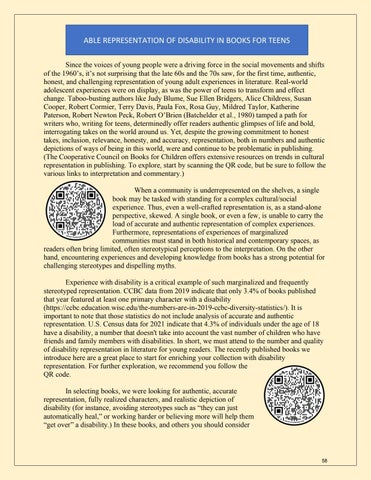ABLE REPRESENTATION OF DISABILITY IN BOOKS FOR TEENS Since the voices of young people were a driving force in the social movements and shifts of the 1960’s, it’s not surprising that the late 60s and the 70s saw, for the first time, authentic, honest, and challenging representation of young adult experiences in literature. Real-world adolescent experiences were on display, as was the power of teens to transform and effect change. Taboo-busting authors like Judy Blume, Sue Ellen Bridgers, Alice Childress, Susan Cooper, Robert Cormier, Terry Davis, Paula Fox, Rosa Guy, Mildred Taylor, Katherine Paterson, Robert Newton Peck, Robert O’Brien (Batchelder et al., 1980) tamped a path for writers who, writing for teens, determinedly offer readers authentic glimpses of life and bold, interrogating takes on the world around us. Yet, despite the growing commitment to honest takes, inclusion, relevance, honesty, and accuracy, representation, both in numbers and authentic depictions of ways of being in this world, were and continue to be problematic in publishing. (The Cooperative Council on Books for Children offers extensive resources on trends in cultural representation in publishing. To explore, start by scanning the QR code, but be sure to follow the various links to interpretation and commentary.) When a community is underrepresented on the shelves, a single book may be tasked with standing for a complex cultural/social experience. Thus, even a well-crafted representation is, as a stand-alone perspective, skewed. A single book, or even a few, is unable to carry the load of accurate and authentic representation of complex experiences. Furthermore, representations of experiences of marginalized communities must stand in both historical and contemporary spaces, as readers often bring limited, often stereotypical perceptions to the interpretation. On the other hand, encountering experiences and developing knowledge from books has a strong potential for challenging stereotypes and dispelling myths. Experience with disability is a critical example of such marginalized and frequently stereotyped representation. CCBC data from 2019 indicate that only 3.4% of books published that year featured at least one primary character with a disability (https://ccbc.education.wisc.edu/the-numbers-are-in-2019-ccbc-diversity-statistics/). It is important to note that those statistics do not include analysis of accurate and authentic representation. U.S. Census data for 2021 indicate that 4.3% of individuals under the age of 18 have a disability, a number that doesn't take into account the vast number of children who have friends and family members with disabilities. In short, we must attend to the number and quality of disability representation in literature for young readers. The recently published books we introduce here are a great place to start for enriching your collection with disability representation. For further exploration, we recommend you follow the QR code. In selecting books, we were looking for authentic, accurate representation, fully realized characters, and realistic depiction of disability (for instance, avoiding stereotypes such as “they can just automatically heal,” or working harder or believing more will help them “get over” a disability.) In these books, and others you should consider
58






